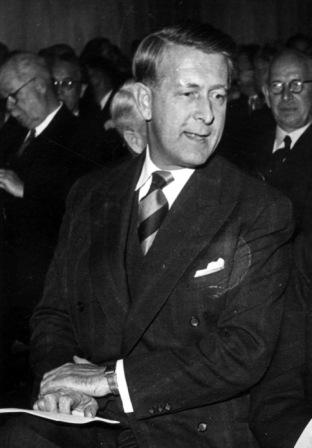- Bertil Ohlin
Infobox scientist
name = Bertil Ohlin
image_size = 180px
caption = Bertil Ohlin at Arosmässan inVästerås (late 1950s).
birth_date = birth date|1899|4|23
birth_place = Klippan,Sweden
death_date = death date and age|1979|8|3|1899|4|23
death_place =Valadalen ,Sweden
field =Economics
work_institution =University of Copenhagen (1925–1930)Stockholm School of Economics (1930–1965)
alma_mater = B.A.Lund University (1917) M.A.Harvard University (1923) Ph.D.Stockholm University (1924)
doctoral_advisor =Gustav Cassel
doctoral_students =
known_for =Heckscher-Ohlin model Heckscher-Ohlin theorem
prizes =Nobel Memorial Prize in Economic Sciences (1977)Bertil Gotthard Ohlin (pronounced|ˈbærtil uˈliːn) (
23 April 1899 –3 August 1979 ) was a Swedisheconomist andpolitician . He was a professor ofeconomics at theStockholm School of Economics from 1929 to1965. He was also leader of the People's Party, a social-liberal party which at the time was the largest party in opposition to the governing Social Democratic Party, from 1944 to 1967. He served briefly as Minister for Trade from 1944 to 1945 in the Swedish coalition government during World War II.Ohlin's name lives on in one of the standard mathematical model of international
free trade , theHeckscher-Ohlin model , which he developed together withEli Heckscher . He was jointly awarded theNobel Memorial Prize in Economic Sciences in 1977 together with the British economistJames Meade "for their pathbreaking contribution to the theory ofinternational trade and international capital movements".Biography
Having received his B.A. from
Lund University 1917, and his M.A. fromHarvard University in 1923, Ohlin received his doctorate fromStockholm University in 1924. In 1925 he became a professor at theUniversity of Copenhagen . In 1929 he debated withJohn Maynard Keynes , contradicting the latter's view on the consequences of the heavy war reparations payments imposed on Germany. (Keynes predicted a war caused by the burden of debt, Ohlin thought thatGermany could afford the reparations.) Although Keynes was probably right, the debate was important in the modern theory ofunilateral international payments.In 1930 Ohlin succeeded
Eli Heckscher , his teacher, as a professor ofeconomics , at theStockholm School of Economics . In 1933 Olin published a work that made him world renowned, "Interregional and International Trade". In this Ohlin built an economic theory of international trade from earlier work by Heckscher and his own doctoral thesis. It is now known as theHeckscher-Ohlin model , one of the standard model economists use to debate trade theory.The model was a break-through because it showed how
comparative advantage might relate to general features of a country'scapital and labour, and how these features might change through time. The model provided a basis for later work on the effects of protection onreal wages, and has been fruitful in producing predictions and analysis; Ohlin himself used the model to derive theHeckscher-Ohlin theorem , that nations would specialize in industries most able to utilize their mix of national resources efficiently. Today, the theory has been largely disproved, yet it is still a useful framework by which to understand international trade.Later, Ohlin and other members of the "
Stockholm school " extendedKnut Wicksell 's economic analysis to produce a theory of the macroeconomy anticipatingKeynesianism .Ohlin was party leader of the liberal Liberal People's Party from 1944 to 1967, the main opposition party to the Social Democrat Governments of the era, and from '44 to '45 was "minister of commerce" in the wartime government. His daughter
Anne Wibble , representing the same party, served as Minister of Finance in 1991-1994.Heckscher-Ohlin theorem
The Heckscher-Ohlin Theoem, which is concluded from the
Heckscher-Ohlin model of international trade, states: trade between countries is in proportion to their relative amounts of capital and labor. In countries with an abundance of capital, wage rates tend to be high; therefore, labor-intensive products, e.g. textiles, simple electronics, etc., are more costly to produce internally. In contrast, capital-intensive products, e.g. automobiles, chemicals, etc., are relatively less costly to produce internally. Countries with large amounts of capital will export capital-intensive products and import labor-intensive products with the proceeds. Countries with high amounts of labor will do the reverse.The following conditions must be true:
* The major factors of production, namely labor and capital, are not available in the same proportion in both countries.
* The two goods produced either require relatively more capital or relatively more labor.
* Labor and capital do not move between the two countries.
* There are no costs associated with transporting the goods between countries.
* The citizens of the two trading countries have the same needs.The theory does not depend on total amounts of capital or labor, but on the amounts per worker. This allows small countries to trade with large countries by specializing in production of products that use the factors which are more available than its trading partner. The key assumption is that capital and labor are not available in the same proportions in the two countries. That leads to specialization, which in turn benefits the country’s economic welfare. The greater the difference between the two countries, the greater the gain from specialization.
Wassily Leontief made a study of the theory that seemed to invalidate it. He noted that the United States had a lot of capital; therefore, it should export capital-intensive products and import labor-intensive products. Instead, he found that it exported products that used more labor than the products it imported. This finding is known as theLeontief paradox .See also
*
Contributions to liberal theory
*Ohlin Report (1956)
*Faustman-Ohlin theorem Significant Publications
* "The German Reparations Problem", 1930
* "Interregional and International Trade", 1933
* "Mechanisms and Objectives of Exchange Controls", 1937Bibliography
* [http://www.britannica.com/ebc/article-61690 Encyclopedia Britannica Online "International trade"]
* [http://nobelprize.org/economics/educational/trade/ohlin.html NobelPrize.org "Why Trade?"]
* [http://www.internationalecon.com/v1.0/ch60/60c010.html Chapter 60 The Heckscher-Ohlin (Factor Proportions) Model]Further reading
*cite book |author=John Cunningham Wood |title=Bertil Ohlin: Critical Assessments |publisher=Routledge |year=1995 |id=ISBN 978-0415074926
External links
* [http://www.nobel-winners.com/Economics/bertil_ohlin.html Bertil Ohlin]
* [http://www.ohlininstitutet.org/ Bertil Ohlin Institute]
* [http://www.economyprofessor.com/theorists/bertilohlin.php Ohlin's life in economics]
* [http://nobelprize.org/economics/laureates/1977/ohlin-autobio.html Bertil Ohlin – Autobiography]
* [http://nobelprize.org/economics/laureates/1977/ohlin-lecture.pdf Nobel lecture]
* [http://www.iies.su.se/publications/seminarpapers/684.pdf Presentation: THE YOUNG OHLIN ON THE THEORY OF INTERREGIONAL AND INTERNATIONAL TRADE]
* [http://ideas.repec.org/e/poh2.html IDEAS/RePEc]
Wikimedia Foundation. 2010.
